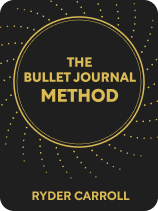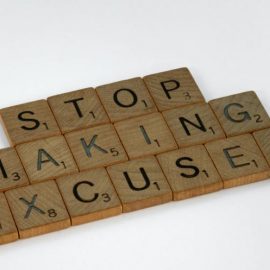

This article is an excerpt from the Shortform book guide to "The Bullet Journal Method" by Ryder Carroll. Shortform has the world's best summaries and analyses of books you should be reading.
Like this article? Sign up for a free trial here .
Do you have trouble letting go? How can Bullet Journaling (aka BuJo) help you let go of what you can’t control?
Instead of immediately reacting to a situation, taking the time to step back and record your feelings in your Bullet Journal daily log can help you reflect. Then, if a situation needs to be acted upon, it can help you map out the next steps. If not, Bullet Journaling can help you let go of what you can’t control.
Here’s how to use a Bullet Journal to come to terms with situations.
Learning to Let Go
Carroll says that learning to differentiate between what we can and can’t control is vital to living a high-quality life. By letting go of what you can’t control and choosing to focus instead on how we respond to them, we can shift our mindset from reactive to responsive. Of course, Carroll acknowledges, letting go can be difficult because there are many displeasing things outside of our control: world events, other people, and even our own feelings.
(Shortform note: In explaining the importance of differentiating between what we can and can’t control, Carroll doesn’t explore why we feel such a strong need to control things. According to research, feeling as if we have control makes us trust ourselves as competent beings with agency. It also reassures us that we aren’t under the control of others. Research shows that both of these beliefs positively affect our well-being.)
Yet another obstacle in our way, according to Carroll, is our fear of change; although we understand that change is inevitable and often uncontrollable, we are nevertheless afraid of it and often resist it.
(Shortform note: According to psychologists, despite our fear of change, humans are highly capable of adapting thanks to resilience. Rather than something you’re born with, resilience is a skill that you can develop over time by working on four core components—building connections with others, maintaining overall wellness, developing healthy ways of thinking, and finding purpose.)
The Bullet Journal Solution
Despite these challenges, Carroll argues that it’s possible to adjust your mindset and let go of the uncontrollable. One way to do this is to use your daily log to reflect on situations after they’ve occurred. He argues that by putting your thoughts on paper, you can see things more clearly and prevent yourself from acting irrationally.
(Shortform note: How exactly does writing help you clarify your thoughts? Writing allows you to frame your ideas in a cohesive way, prioritize the most important information, reconcile different viewpoints, and solidify your argument. All of these are important when deciding how to respond to a situation.)
Instead of immediately reacting to a triggering uncontrollable event, Carroll suggests that you pause to allow yourself to process what occurred. Then, during your nightly review, write a letter to yourself in your daily log, using it as a safe space to express your feelings and consider your options for how to respond to the situation.
For example, your first reaction after being stood up on a date might be to send an angry text message to the person. After putting your thoughts down on paper, however, you may realize that you shouldn’t make assumptions about why they didn’t show up for the date—perhaps they had an emergency.
(Shortform note: Research on the benefits of expressive writing has provided some evidence in support of Carroll’s strategy. In one study, for example, participants who had recently lost their jobs were divided into three groups: One group wrote about their emotions surrounding their job loss, one group wrote about topics unrelated to traumatic experiences, and one group didn’t write at all. The results showed that those who specifically wrote about their job loss were re-employed more quickly, presumably because writing expressively helped them to change their perspectives on the situation and move on positively.)
Another strategy Carroll recommends for adjusting your perspective is reframing tasks that are outside of your control. He says that often, the reason tasks seem outside of your control is because they’re focused on the outcome, which you may have no power over. For example, a task like “cook a healthy meal that my kids like” is focused on the preferences of others, which you can’t control.
To shift that focus, Carroll suggests that you break such tasks down further into smaller, actionable steps. This is because smaller steps tend to focus on the process rather than the outcome and thus are within your control. For example, you could break down “cook a healthy meal that my kids like” into something smaller like “find a new healthy recipe to make this week.” This task, in contrast, can be completed successfully regardless of your kids’ opinions.
| Outcome vs. Process Goals: Is One Better Than the Other? Carroll encourages readers to break down outcome-focused tasks into processed-focused steps. However, this suggestion seems to imply that goals focused on outcome should always be avoided. This begs the question: Is there ever any use for outcome goals? According to experts, outcome goals are helpful if you use them in tandem with process goals, where process goals define the steps necessary to achieve the desired outcome. For example, if your outcome goal is to run a marathon, your process goals would be smaller actions you could take to work toward that achievement, such as weight training twice a week. The benefit of setting both types of goals is that you can clarify what you hope to ultimately achieve while avoiding the overwhelm of trying to do too much at once. Additionally, you can challenge yourself to rise above what you ever thought possible while maintaining a clear sense of how to get there. |

———End of Preview———
Like what you just read? Read the rest of the world's best book summary and analysis of Ryder Carroll's "The Bullet Journal Method" at Shortform .
Here's what you'll find in our full The Bullet Journal Method summary :
- A comprehensive guide to using the Bullet Journal Method
- How to maintain a journaling practice that can improve your overall quality of life
- How to extend the method beyond productivity to a practice in mindfulness






